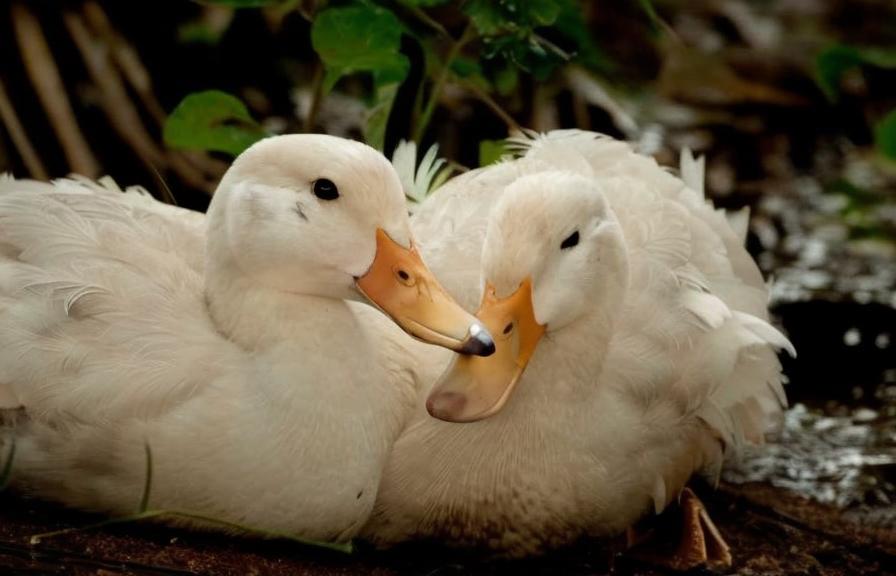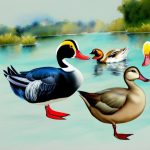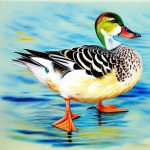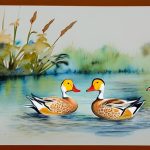Long necked duck breeds are a unique and fascinating group of waterfowl that have captured the attention of bird enthusiasts and farmers alike. These ducks are known for their distinctive long necks, which set them apart from other duck breeds. Long necked ducks come in a variety of colors and patterns, and they are prized for their beauty as well as their utility. In addition to being popular for ornamental purposes, long necked duck breeds are also valued for their meat and eggs. They are hardy and adaptable birds that can thrive in a range of environments, making them a versatile choice for farmers and hobbyists.
Long necked duck breeds have a rich history that dates back centuries. They have been bred and raised in various parts of the world, and their unique characteristics have made them a favorite among bird enthusiasts. These ducks are known for their graceful appearance and elegant movements, and they are often featured in art and literature as symbols of beauty and grace. Long necked duck breeds have also played an important role in traditional farming practices, providing a valuable source of food and income for many communities. Today, these ducks continue to be cherished for their striking appearance and practical benefits, making them a popular choice for anyone interested in raising waterfowl.
Key Takeaways
- Long necked duck breeds are known for their unique physical features and are popular among duck enthusiasts.
- Long necked duck breeds have distinct characteristics such as elongated necks, upright posture, and elegant appearance.
- Some popular long necked duck breeds include the Indian Runner, Magpie, and Saxony ducks.
- Care and maintenance of long necked duck breeds require proper housing, feeding, and regular health check-ups.
- Breeding and reproduction of long necked duck breeds involve providing suitable nesting areas and monitoring the hatching process for healthy offspring.
Characteristics and Physical Features of Long Necked Duck Breeds
Long necked duck breeds are easily recognizable by their elongated necks, which give them a distinctive and elegant appearance. These ducks typically have slender bodies and long, graceful necks that set them apart from other duck breeds. Their heads are often small and rounded, with bright, expressive eyes that give them a charming and endearing look. Long necked duck breeds come in a variety of colors and patterns, including solid colors, pied patterns, and intricate markings. Their feathers are often glossy and iridescent, adding to their overall beauty and appeal.
In addition to their striking appearance, long necked duck breeds are also known for their hardiness and adaptability. These ducks are well-suited to a range of climates and environments, making them a versatile choice for farmers and hobbyists. They are also known for their friendly and sociable nature, making them a popular choice for anyone looking to raise ducks as pets. Long necked duck breeds are also valued for their practical benefits, including their ability to lay large, flavorful eggs and their delicious, tender meat. Overall, these ducks are prized for their combination of beauty, utility, and friendly disposition, making them a popular choice for anyone interested in raising waterfowl.
Popular Long Necked Duck Breeds
There are several popular long necked duck breeds that are prized for their unique characteristics and practical benefits. One of the most well-known long necked duck breeds is the Indian Runner duck, which is famous for its upright posture and distinctive long neck. Indian Runner ducks come in a variety of colors, including white, fawn, and black, and they are valued for their prolific egg-laying abilities. Another popular long necked duck breed is the Khaki Campbell duck, which is known for its excellent egg production and calm, friendly demeanor. Khaki Campbell ducks come in shades of khaki and brown, and they are prized for their hardiness and adaptability.
In addition to Indian Runner and Khaki Campbell ducks, there are several other long necked duck breeds that are popular among bird enthusiasts and farmers. The Magpie duck is known for its striking black-and-white markings and friendly disposition, making it a popular choice for both ornamental and practical purposes. The Welsh Harlequin duck is another popular long necked breed that is prized for its beautiful silver coloring and excellent egg-laying abilities. Overall, long necked duck breeds offer a wide range of options for anyone interested in raising waterfowl, with each breed offering its own unique combination of beauty, utility, and friendly temperament.
Care and Maintenance of Long Necked Duck Breeds
Long necked duck breeds require proper care and maintenance to ensure their health and well-being. These ducks should be provided with a spacious and secure enclosure that offers protection from predators and the elements. They also need access to clean water for swimming and bathing, as well as plenty of space to forage and exercise. Long necked duck breeds should be fed a balanced diet that includes a mix of commercial duck feed, fresh greens, and occasional treats such as mealworms or cracked corn. It’s important to provide adequate shelter and protection from extreme temperatures, as well as regular veterinary care to monitor their health.
In addition to providing proper housing and nutrition, long necked duck breeds also require regular grooming and maintenance. Their enclosures should be cleaned regularly to prevent the buildup of waste and bacteria, and their water should be changed frequently to ensure cleanliness. Long necked duck breeds should also be monitored for signs of illness or injury, and they should receive prompt veterinary care if needed. Overall, proper care and maintenance are essential for ensuring the health and well-being of long necked duck breeds, allowing them to thrive and flourish in a domestic setting.
Breeding and Reproduction of Long Necked Duck Breeds
Breeding long necked duck breeds can be a rewarding experience for farmers and hobbyists alike. These ducks are known for their prolific egg-laying abilities, making them a valuable source of fresh eggs for consumption or hatching. Long necked duck breeds typically reach sexual maturity at around 5-6 months of age, at which point they can begin laying eggs. The eggs should be collected daily to prevent them from being damaged or eaten by predators, and they can be used for consumption or placed in an incubator for hatching.
When breeding long necked duck breeds, it’s important to provide proper nesting boxes or areas where the ducks can lay their eggs in peace. The nesting boxes should be filled with clean bedding material to provide a comfortable and secure environment for the ducks to lay their eggs. Once the eggs are laid, they should be collected promptly and either consumed or placed in an incubator for hatching. Long necked duck breeds are generally good mothers and will take care of their young, but it’s important to monitor the hatching process and provide any necessary assistance to ensure the health and safety of the ducklings.
Health and Common Issues in Long Necked Duck Breeds

Long necked duck breeds are generally hardy and resilient birds, but they can still be susceptible to certain health issues if not properly cared for. One common health issue in ducks is respiratory infections, which can be caused by poor ventilation or exposure to damp or drafty conditions. Respiratory infections can cause symptoms such as coughing, sneezing, and difficulty breathing, and they should be promptly treated by a veterinarian to prevent further complications. Another common health issue in ducks is bumblefoot, which is a bacterial infection that affects the feet and can cause swelling, redness, and lameness. Bumblefoot can be prevented by providing clean bedding material and regular foot inspections, as well as prompt treatment if any signs of infection are detected.
In addition to respiratory infections and bumblefoot, long necked duck breeds can also be susceptible to parasites such as mites and lice. These parasites can cause irritation, feather loss, and skin damage if left untreated, so it’s important to regularly inspect the ducks for signs of infestation and provide appropriate treatment if necessary. Ducks should also be vaccinated against common diseases such as duck viral enteritis (DVE) and avian influenza to prevent outbreaks and ensure their long-term health. Overall, regular veterinary care, proper nutrition, and good hygiene practices are essential for maintaining the health and well-being of long necked duck breeds.
The Appeal of Long Necked Duck Breeds
Long necked duck breeds offer a unique combination of beauty, utility, and friendly temperament that make them a popular choice for bird enthusiasts and farmers alike. These ducks are prized for their striking appearance, with their long necks and graceful movements setting them apart from other waterfowl. They also offer practical benefits such as prolific egg-laying abilities and delicious meat, making them a valuable addition to any farm or homestead. In addition to their beauty and utility, long necked duck breeds are known for their friendly and sociable nature, making them a popular choice for anyone looking to raise ducks as pets.
Overall, long necked duck breeds have a rich history and continue to be cherished for their unique characteristics and practical benefits. Whether raised for ornamental purposes or for their eggs and meat, these ducks offer a wide range of options for anyone interested in raising waterfowl. With proper care and maintenance, long necked duck breeds can thrive in a domestic setting, providing beauty, companionship, and valuable resources for their owners. Whether you’re an experienced farmer or a first-time bird enthusiast, long necked duck breeds offer an appealing choice that combines beauty, utility, and friendly temperament in one elegant package.
If you’re interested in learning more about long-necked duck breeds, you might also want to check out this informative article on whether geese can eat chicken feed. Understanding the dietary needs of different poultry breeds is essential for their health and well-being.
FAQs
What are long necked duck breeds?
Long necked duck breeds are a group of duck breeds that are characterized by their long necks, which set them apart from other duck breeds. These breeds are known for their elegant appearance and are popular among duck enthusiasts.
What are some examples of long necked duck breeds?
Some examples of long necked duck breeds include the Indian Runner, the Magpie, the Saxony, and the Welsh Harlequin. These breeds are known for their distinctive long necks and come in a variety of colors and patterns.
What are the characteristics of long necked duck breeds?
Long necked duck breeds are known for their long, slender necks, which give them a graceful and elegant appearance. They are also known for their upright posture and active nature. These breeds are generally good layers and are often kept for both ornamental and practical purposes.
What are the uses of long necked duck breeds?
Long necked duck breeds are used for a variety of purposes, including egg production, meat production, and ornamental purposes. Some people also keep them as pets or for exhibition purposes due to their unique and attractive appearance.
How do you care for long necked duck breeds?
Caring for long necked duck breeds involves providing them with a suitable living environment, a balanced diet, and regular access to water for swimming and foraging. They also require regular health checks and protection from predators.
Meet Walter, the feathered-friend fanatic of Florida! Nestled in the sunshine state, Walter struts through life with his feathered companions, clucking his way to happiness. With a coop that’s fancier than a five-star hotel, he’s the Don Juan of the chicken world. When he’s not teaching his hens to do the cha-cha, you’ll find him in a heated debate with his prized rooster, Sir Clucks-a-Lot. Walter’s poultry passion is no yolk; he’s the sunny-side-up guy you never knew you needed in your flock of friends!







